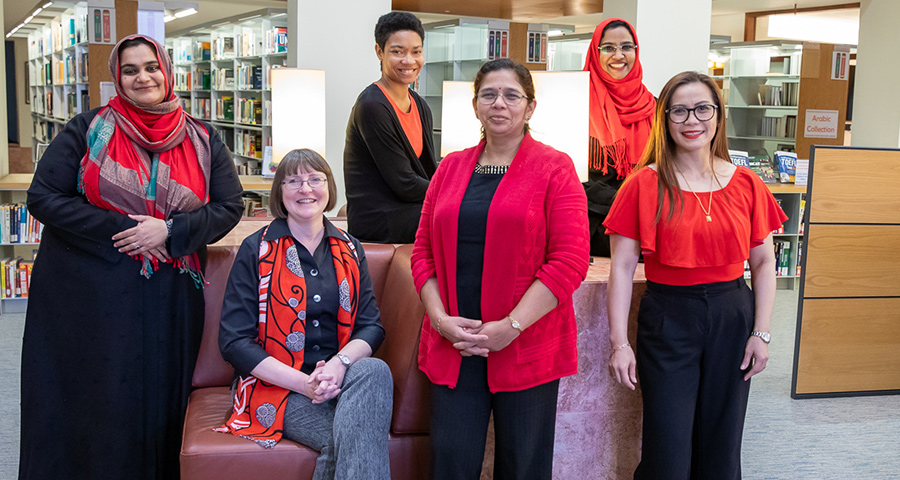
The future of libraries in a social distancing world
Along with the rest of campus, the CMU-Q Library has moved online. CMU-Q News had a Zoom interview with Teresa MacGregor, the director of the library, to learn what the pandemic might mean for our library and the libraries of the future.

Teresa MacGregor
Has the move online been smooth?
Our first challenge was textbooks. Students could no longer visit the library to access our textbook reserves, and many students left campus, or Qatar, without their print books. Thankfully, within just a week of our move to remote teaching, the major e-textbook platforms made their books available for free to participating universities, including Carnegie Mellon. It was such a relief when I was able to send the access instructions for the free e-textbooks to our community.
For many other resources, we can find digital versions in our collection. And now, students can find us online, too. We schedule Zoom office hours for thesis students, and every day we answer questions and fulfill requests via email. I developed the motto, “Online… but never remote” to let our community know we are here for them.
Right now people can only get electronic resources from you?
In extreme cases, we can arrange access to physical resources. However, for most of the requests we have received, the content is available electronically from our own collection or through alternative sources. We are grateful for the amazing digital collections at the Qatar National Library. The QNL has come through in a few cases recently so that we were able to provide almost instantaneous access versus the inevitable delay of interlibrary loan.
Do students prefer electronic books?
No. Both my research at CMU-Q on e-textbooks and research conducted by colleagues on university students worldwide, shows that people prefer to read their academic texts in print and they absorb information more from reading in print. There are many possible reasons; one is the tactile experience, another is our lifelong familiarity with (or you could say practice using) print.
As many students are making the shift to electronic resources, do you have advice on how they can make the e-reading experience better?
Format preference is influenced by the effective use of e-reading tools. When I introduce students to e-textbooks, I ask, ‘okay, so when you get a new app on your phone, you immediately go to the help screens and read all the instructions, right?’ And they laugh. ‘Of course not, you just play around with the app. So, do the same with your e-textbook.’ This is the best method for improving your e-book experience. The e-reading platforms have features for highlighting, note-taking, sharing notes, creating flash cards, reading aloud, and more. Click on every button and open every tab to discover what works for you.
The CMU-Q Library is known as a gathering place. What does that look like right now?
We have a lot of ways that we are reaching out to students. For example, Jasmine Kirby, our instruction and engagement librarian, publishes a newsletter that is light and optimistic, but also offers support for students. This month we are challenging our community to create a ‘zine,’ or self-published magazine, about their lives in quarantine (nicknamed Quaranzines). Jasmine’s newsletter also highlights ways that students can participate in virtual volunteering and citizen science, along with interesting articles about a variety of timely topics.

The CMU-Q Library is now working remotely
Does this era of social distancing and electronic resources mean the end of libraries?
Over the decades, libraries have existed through, and overcome, turbulent times. Cheap print books, bookstores with coffee shops, computers, Google—all of these developments were considered the death knell of libraries. And yet, libraries remain. In fact, I read a statistic recently that library usage was up in 2019. What that says to me is that while the times, the technologies, the social situations change, the service and support provided by libraries is always required. In fact, libraries may be more important during turbulent times as we offer the trifecta of information, escapism, and normality.
A lot of people are thinking ahead to when the quarantine is finished. How will the pandemic change the way that libraries work?
Libraries are purposely designed for, and absolutely dedicated to, supporting their communities. In this crazy time, our library is still helping students, faculty, and staff locate the resources they need to learn, teach, research, and pass the time. Public libraries are doing the same, including for the less privileged and more vulnerable segments of their communities. In person or online, the need is still there, so libraries are still there.
Finally, libraries are information spaces. That could mean a big building full of books, a small room with a few computers, a makerspace with 3D printers, or a virtual world for sharing ideas. In every case, libraries are spaces full of people – librarians, library staff, and patrons. So while they may look different in the future, at the heart of it libraries will remain spaces to collect, archive and, most importantly, share knowledge.
Explore the many resources of the CMU-Q Library at http://www.library.cmu.edu/qatar.
Lear more about Quaranzines at https://guides.library.cmu.edu/quaranzines/home
